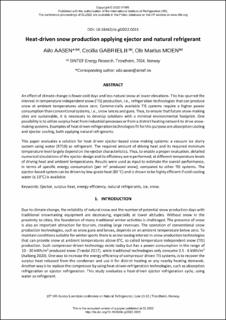| dc.contributor.author | Aasen, Ailo | |
| dc.contributor.author | Gabrielii, Cecilia H | |
| dc.contributor.author | Moen, Ole Marius | |
| dc.date.accessioned | 2022-11-03T10:07:56Z | |
| dc.date.available | 2022-11-03T10:07:56Z | |
| dc.date.created | 2022-10-14T11:08:33Z | |
| dc.date.issued | 2022 | |
| dc.identifier.citation | 15th IIR-Gustav Lorentzen Conference on Natural Refrigerants - GL2022 - Proceedings - Trondheim, Norway, June 13-15th 2022 | en_US |
| dc.identifier.isbn | 978-2-36215-045-6 | |
| dc.identifier.issn | 0151-1637 | |
| dc.identifier.uri | https://hdl.handle.net/11250/3029810 | |
| dc.description.abstract | An effect of climate change is fewer cold days and less natural snow at lower elevations. This has spurred the interest in temperature independent snow (TIS) production, i.e., refrigeration technologies that can produce snow at ambient temperatures above zero. Commercially available TIS systems require a higher power consumption than conventional systems, i.e., snow lances and guns. Thus, to ensure that future snow-making sites are sustainable, it is necessary to develop solutions with a minimal environmental footprint. One possibility is to utilize surplus heat from industrial processes or from a district heating network to drive snow-making systems. Examples of heat driven refrigeration technologies fit for this purpose are absorption cooling and ejector cooling, both applying natural refrigerants. This paper evaluates a solution for heat driven ejector-based snow making systems: a vacuum ice slurry system using water (R718) as refrigerant. The required amount of driving heat and its required minimum temperature level largely depend on the ejector characteristics. Thus, to enable a proper evaluation, detailed numerical simulations of the ejector design and its efficiency were performed, at different temperature levels of driving heat and ambient temperatures. Results were used as input to estimate the overall performance, in terms of specific energy consumption (per m3 produced snow), compared to other TIS systems. The ejector-based system can be driven by low-grade heat (80 °C) and is shown to be highly efficient if cold cooling water (≤ 10°C) is available. | en_US |
| dc.description.abstract | Heat-driven snow production applying ejector and natural refrigerant | en_US |
| dc.language.iso | eng | en_US |
| dc.publisher | IIR | en_US |
| dc.relation.ispartof | 15th IIR-Gustav Lorentzen Conference on Natural Refrigerants - GL2022 - Proceedings - Trondheim, Norway, June 13-15th 2022 | |
| dc.relation.ispartofseries | Science et technique du froid; | |
| dc.title | Heat-driven snow production applying ejector and natural refrigerant | en_US |
| dc.title.alternative | Heat-driven snow production applying ejector and natural refrigerant | en_US |
| dc.type | Chapter | en_US |
| dc.type | Peer reviewed | en_US |
| dc.description.version | acceptedVersion | en_US |
| dc.rights.holder | Copyright © 2022 IIF/IIR. Published with the authorization of the International Institute of Refrigeration (IIR). The conference proceedings of GL2022 are available in the Fridoc database on the IIR website at www.iifiir.org | en_US |
| dc.identifier.cristin | 2061436 | |
| dc.source.articlenumber | 0031 | en_US |
| cristin.ispublished | true | |
| cristin.fulltext | postprint | |
| cristin.qualitycode | 1 | |
